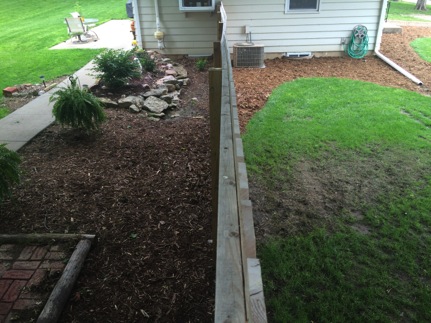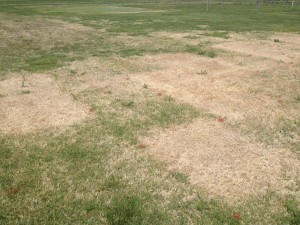By Dani McFadden, Graduate Research Assistant, Horticulture and Natural Resources
It is that time of year when winter annuals and cool-season broadleaf weeds start emerging. Understanding how your herbicide is interacting in the soil and within the plant is important for effective weed control. Let’s take a shallow dive into the world of herbicide interactions so you’ll better understand the process a plant undergoes after an application.
Mode of action explains the entire sequence of events that happens from herbicide application to plant death, this includes the uptake, translocation and metabolism. This term is often confused with mechanism of action or site of action, which is the specific location at the cellular level where the disruption occurs. Contact herbicides (ex. diquat) injure the plant wherever they touch the plant, and often work quickly. We find that contact herbicides are more effective on small annual weeds compared to perennial weeds. Systemic herbicides (ex. glyphosate, 2,4-D) must be absorbed by the plant and then move throughout. In contrast to contact herbicides, systemic herbicides are very effective on perennial weeds. Since systemic herbicides are able to translocate to different parts of the plant, they are able to kill perennial weeds at the roots, tubers, and/or rhizomes.
So, how are commonly used herbicides effective against weeds? First, the herbicide needs to effectively contact the plant (more critical for contact herbicides compared to systemic herbicides) and then be absorbed by the plant. The compounds will then move to the site of action, and if there is enough toxicity within the site of action the plant will ultimately die.
Understanding the life cycle and biology of weeds will increase performance of the herbicide. However, there are several factors that can affect the uptake, translocation, and metabolism of the herbicide once it reaches the plant. Plant barriers such as waxy cuticles on the leaf surface or the casparian strip (a band-like wall that blocks the movement of water and solutes in vascular plants) can reduce herbicide uptake. Furthermore, climatic conditions and properties of the herbicide can influence efficacy. Here are some properties of herbicides that will help you understand how it will perform in certain environments at or following application:
- Water solubility (Kow) is important because it affects behavior in the soil, formulation of an active ingredient, and separation of the herbicide into the plant. If herbicides have a high Kow they will be less soluble in water.
- Soil adsorption (Koc) focuses on the retention of herbicide compounds and what influences persistence and availability of the herbicide. Many factors affect how herbicides are adsorbed, such as: moisture, clay content and organic matter, and soil pH. The Koc affects the herbicides tendency to bind to soil particles.
- Volatility and particle drift is the physical drift that occurs during or immediately after application, with smaller droplets being more likely to drift than larger droplets. Furthermore, it is important to note that if the vapor pressure of the herbicide is high, then potential for non-target plant injury increases. Factors increasing volatility after herbicide application include: higher temperatures and increased soil water content. In addition, broadleaf herbicides containing high ester content are more volatile. To reduce volatilization applications can be incorporated into the soil or applied when weather conditions are favorable.
For plant absorption and translocation, herbicides must cross several barriers. It is important to read the herbicide label before use. If a surfactant is recommended, then one should be utilized. A surfactant can aid in decreasing surface tension and increasing absorption.
Topramezone app on goosegrass
Having knowledge on: 1) the biology and life cycle of the weed you are controlling; 2) properties of the herbicide you are applying; and 3) environmental conditions and soil factors at your site will aid in effective weed control.
It is imperative to always READ THE LABEL before applying herbicides for the correct rate, turfgrass tolerance, and important instructions for application.
***Mention of trade names or commercial products in this article is solely for identification purposes and does not imply recommendation or endorsement, nor is criticism implied of similar products not mentioned by Kansas State University.***
 Cool-season broadleaf weeds, including winter annuals and perennials, wait until temperatures cool down and then emerge during autumn. The photo above was taken in Olathe in late October. Targeting broadleaf weeds during autumn, when temperatures are suitable for application, results in good broadleaf weed control. Immature weed seedlings are more susceptible to herbicides than mature weeds. Find more information regarding weed control in this valuable resource. The updated “Turfgrass Weed Control Guide for Professionals – 2021” provides weed identification and control information that turfgrass professionals can use to develop effective weed control programs for golf courses, athletic fields, sod farms, lawns, and other turfgrass systems. The recommendations apply to the majority of the United States, with input from experts in Illinois, Indiana, Iowa, Kansas, Kentucky, Michigan, Minnesota, Missouri, Nebraska, New Jersey, New York, Ohio, Pennsylvania, and Wisconsin.
Cool-season broadleaf weeds, including winter annuals and perennials, wait until temperatures cool down and then emerge during autumn. The photo above was taken in Olathe in late October. Targeting broadleaf weeds during autumn, when temperatures are suitable for application, results in good broadleaf weed control. Immature weed seedlings are more susceptible to herbicides than mature weeds. Find more information regarding weed control in this valuable resource. The updated “Turfgrass Weed Control Guide for Professionals – 2021” provides weed identification and control information that turfgrass professionals can use to develop effective weed control programs for golf courses, athletic fields, sod farms, lawns, and other turfgrass systems. The recommendations apply to the majority of the United States, with input from experts in Illinois, Indiana, Iowa, Kansas, Kentucky, Michigan, Minnesota, Missouri, Nebraska, New Jersey, New York, Ohio, Pennsylvania, and Wisconsin.














